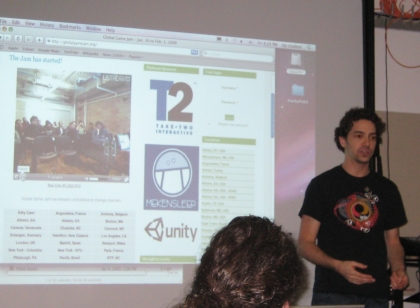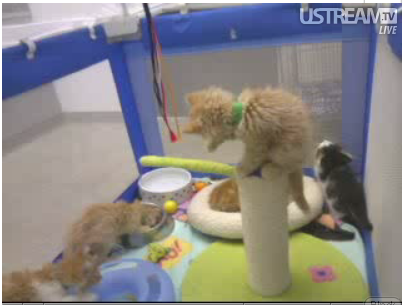The Global Game Jam is a worldwide event lasting 48 hours. In that time period, volunteer game developers, including students, amateurs, and industry professionals get together in small groups (usually 5-6 team members) across 52 worldwide locations and create video games. Not just parts of games, proofs of concept, or model art. Whole. Games. The event is organized by the International Game Developers Association and is an excellent opportunity for industry professionals and hopefuls, to network, brainstorm, and just generally have fun doing what they love.
Each location has a set of not-necessarily-the-same constraints that developers need to apply to the games they create. The idea is that by being forced to work within those constraints (including the short time limit), developers need to quickly identify only one or two key gameplay mechanics they want to build their game around. There really isn’t time for plots and deep storylines (though many developers try anyway); quick, fast casual games are the flavor of the day, and developers need to be able to walk the line between spending too much time on the background of the game and not having an atmospheric hook with which to grab interest.
As might be imagined, many of the 52 event locations are in the United States, and there were actually two locations in New York that I could go to—one at New York University, hosted by the Tisch School’s Interactive Telecommunication Program, and one at Columbia University, hosted by the Teacher’s College. Being a lazy bum living in Jersey, I opted to head to the NYU location, by Washington Square. Once of the first things that I noticed when I got there is that while there was a significant population of IPT students (about half), there was an equal number of IGDA NYC members, local game developers, and hobbyists to round out the group, totaling around 35-40 people. Folks were swapping stories, talking about upcoming projects and past successes (and notable failures), and pretty much the only thing everyone had in common was pure, unadulterated enthusiasm and anticipation.
The event kicked off for the NYU group around 3:30 pm, led by a video keynote by 2D Boy’s Kyle Gabler, co-creator of World of Goo. Kyle explained the basic concept behind the Jam, and gave some friendly advice on how to hit the 48-hour goal.
The aspect ratio of the video keynote isn’t friendly to our layout, but the link is here.
Post-video, the local event organizers, led by Oren Ross from IGDA NY, took over to explain the development constraints for the NYU location, while the Global Game Jam website showed live video streaming of the event over the Web.

It’s actually very impressive that they so smoothly set up streaming video from all the worldwide locations competing against one ano-HEY, WAIT A MINUTE!!

We’re competing against the Kitty Cam?!
That’s…that’s just unfair! Game over, man, game over!

Ahem.
The NYU location had the following 3 constraints beyond the 48 hour time limit.
1) Complete play sessions need to last 5 minutes or less.
2) Align the game around the theme “As long as we have each other, we will never run out of problems.”
3) Incorporate (somehow) any one of these adjectives: illusionary, pointed, persistent.
Once everyone had the measure of the rules, the brainstorming session began. Some locations may do it differently, but the NYU group decided not to be strictly competitive against each other; everyone shared ideas freely and asked for advice, technical help, and feedback.
The initial list of ideas contained eclectic, innovative, intuitive concepts that could be conceivably adapted and developed into full games by the end of the time limit. We had everything from text-based zombie survival to Wii competitive snow-shoveling art.
My own idea was fortunate enough to grab enough attention to form my own team. My premise was that a nuclear fire had wiped out all of earth’s population and that, as the protector of humanity’s last refuge, you used the remains of civilization to build barricades to hold off the oncoming waves of radioactive, blood-sucking Australian fiends looking to feed on humanity’s remnant. Players could use whatever falls randomly onto the game board: trees, rocks, burned-out cars, mutant cows, etc. to build their barricade, and after a pre-set time, the mutant hordes (or whatever) would come and try and bust through the barricade.
One of the key ideas behind the Global game Jam is the realization that in order to adhere to the 48 hour time limit, teams will need to adapt, and games will change iteratively on a regular, and occasionally radical, basis in order to stay within the time limit. So, I’ll be coming to cover the Jam as it continues to describe how the project is evolving, and I expect the final result will little resemble the original idea.










